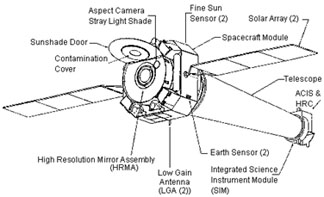An image of the AXAF Observatory
Click on image for full size
Image courtesy of AXAF Science Center (ASC) operated by the Smithsonian Astrophysical Observatory in Cambridge, Massachusetts.
Contest to Name X-ray Observatory
News story originally written on April 22, 1998
AXAF is the most powerful x-ray observatory ever constructed. AXAF stands for Advanced X-ray Astrophysics Facility--try saying that fast three times! It is scheduled for launch on December 3, 1998.
NASA is looking for a new name for the AXAF. Here are the details straight from a NASA news release!
Entries should contain the name of a person (not living),
place, or thing from history, mythology, or fiction. Contestants should describe in a few sentences why this choice would be a good name for AXAF. The name must not have been used before on space missions by NASA or other organizations or countries.
The grand prize will be a trip to NASA's Kennedy Space
Center in Cape Canaveral, FL, to see the launch of the satellite
aboard the Space Shuttle. Ten runner-up prizes will be awarded
and all entrants will receive an AXAF poster.
Entries also can be mailed to: AXAF Contest, AXAF Science
Center, Office of Education and Public Outreach, 60 Garden Street,
MS 83, Cambridge, MA 02138. Mailed entries must be postmarked no
later than June 30, 1998.
You might also be interested in:

It was another exciting and frustrating year for the space science program. It seemed that every step forward led to one backwards. Either way, NASA led the way to a great century of discovery. Unfortunately,
...more
The Space Shuttle Discovery lifted off from Kennedy Space Center on October 29th at 2:19 p.m. EST. The sky was clear and the weather was great. This was the America's 123rd manned space mission. A huge
...more
Scientists found a satellite orbiting the asteroid, Eugenia. This is the second one ever! A special telescope allows scientists to look through Earth's atmosphere. The first satellite found was Dactyl.
...more
The United States wants Russia to put the service module in orbit! The module is part of the International Space Station. It was supposed to be in space over 2 years ago. Russia just sent supplies to the
...more
A coronal mass ejection (CME) happened on the Sun last month. The material that was thrown out from this explosion passed the ACE spacecraft. ACE measured some exciting things as the CME material passed
...more
Trees and plants are a very important part of this Earth. Trees and plants are nature's air conditioning because they help keep our Earth cool. On a summer day, walking bare-foot on the sidewalk burns,
...more
There is something special happening in the night sky. Through mid-May, you will be able to see five planets at the same time! This doesn't happen very often, so you won't want to miss this. Use the links
...more















